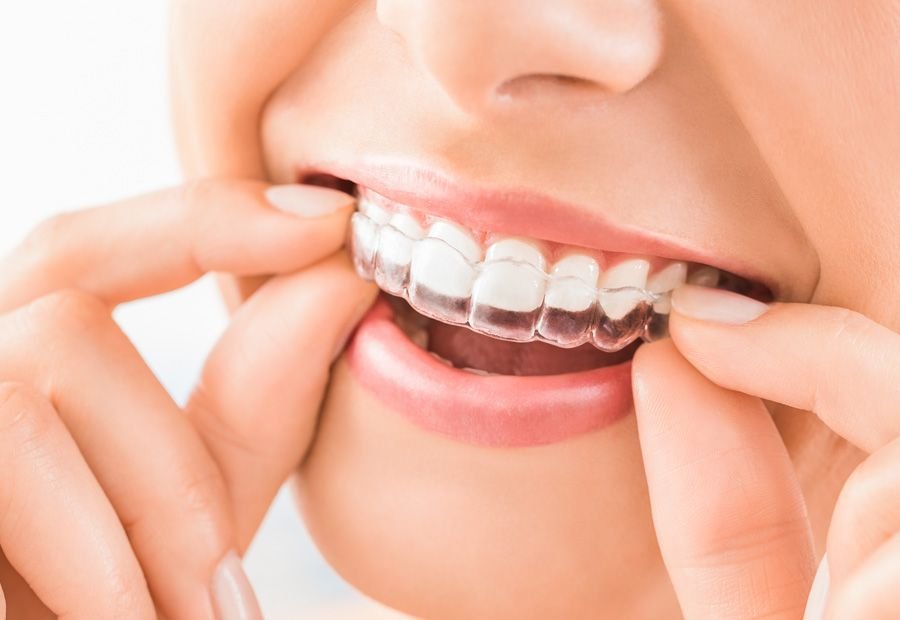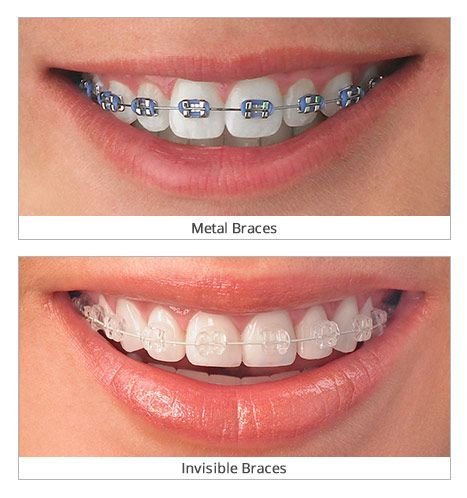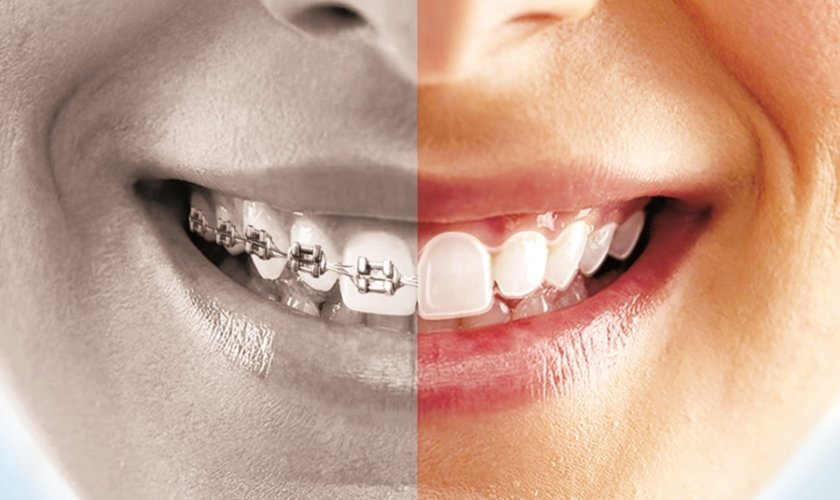Aligners vs braces is a common consideration for anyone seeking a perfect smile through orthodontic treatment. This ultimate comparison explores the nuances of both orthodontic treatments, aiding individuals in making informed choices tailored to their specific needs and preferences.
In this guide, we’ll delve into the key aspects of aligners vs braces, covering factors such as:
- Appearance
- Treatment duration
- Removability
- Comfort
- Maintenance
- Cost
What are aligners?
Teeth aligners are clear, removable dental devices used to align and strengthen teeth for proper biting. They are typically made of clear plastic and are custom-designed to fit snugly over the patient’s teeth.
The most well-known brand of aligners is probably Invisalign, but there are others on the market as well. The aligners are worn for a certain amount of time each day, usually around 20 to 22 hours, and are replaced with a new set approximately every one to two weeks. Each new set of aligners gradually shifts the teeth into the desired position, as planned by the orthodontist.
Aligners offer several advantages over traditional braces, such as being virtually invisible, removable for eating and cleaning, and often causing less discomfort. However, they may not be suitable for all orthodontic issues, and the success of treatment depends on the patient’s compliance with wearing them as directed by their orthodontist.

How do aligners work?
Aligners are dental devices designed to straighten teeth by applying gentle pressure over time. They work by compressing the periodontal ligament of each tooth, which constricts blood vessels and activates osteoclasts and osteoblasts. These cells anchor the teeth in their new desired position.
Wearing aligners for at least 22 hours daily is recommended to achieve the desired result. This helps maintain the pressure the aligners apply, resulting in more effective treatment.
Pros and cons of aligners
Like every other device, aligners have advantages and disadvantages, making it the best choice for others, whereas others will choose braces.
The pros of aligners include:
- Aligners are good and easier to manage because they are easily removable and can easily be cared for. There are various strategies for oral health care when using dental aligners in Australia.
- Smooth hence do not irritate the oral mucosal.
- Readily available
- Transparent or invisible dental aligners are hence aesthetically appealing.
The cons of aligners include:
- Expensive
- Difficult to treat complex issues
- Must be worn for at least 22 hours to obtain the desired effect
- Aligners take a long time to achieve the desired teeth alignment.
- Requires care in removing and putting it back
What are braces?
Braces are orthodontic appliances that are used to straighten and align teeth, and improve the bite of a person. They are usually made of metal or porcelain brackets that are attached to the teeth and connected by wires. Bracelets usually appear in different colors and can be made up of different materials including metals or ceramic. The duration of the process can vary from several months to a few years depending on the severity of the misalignment.
While braces may cause some discomfort, particularly after adjustments, they are highly effective at correcting a wide range of dental misalignments and bite problems.

How do braces work?
Like aligners, braces work by applying pressure to the teeth which gradually moves them into position. The wires apply pressure on the teeth, which gradually moves them into the correct position. With time, the patient is often required to go for fastening of the braces.
Pros and cons of braces
Braces are very good in maintaining teeth alignment and are very common in Australia making it a good choice for many people. Nevertheless, braces like any other device have their pros and cons.
Pros of braces.
- Affordable
- Durable and not prone to destruction
- Can treat very complex orthodontic problems
- Colors can be easily changed making it dynamic. There are some ways to know the right color for your braces.
Cons of braces
- They can not be easily removed
- They are visible and may not be appealing
- Regular dental checks to tighten the wires
- Painful when first placed
- Last long and have a long treatment time usually about 2 to 3 years.
Aligners vs braces
The concept of aligners vs braces is challenging when it comes to choice but depending on an individual’s need, they can choose what they want. To make an informed decision, it’s important to analyze factors such as cost, treatment time, removability, appearance, comfort and convenience, and maintenance and care.
Cost
Orthodontic treatments in Australia can be quite expensive and the cost varies depending on factors such as the duration of treatment, the type of treatment, and the location of the orthodontist. The cost of braces in Australia can range from AUD 4,000 to AUD 8,000, depending on the type of braces chosen. On the other hand, the cost of clear aligners generally ranges from AUD 6,500 to AUD 9,500, depending on the duration of treatment and the type of orthodontic treatment required.
It is advisable to check with your health insurance provider to see which treatment they cover. Most health insurance providers in Australia cover the cost of traditional braces, but only a few cover the cost of aligners. Additionally, some orthodontists offer flexible payment plans that allow you to pay in installments or offer discounts if you choose to pay the full cost in one installment.
Treatment time
Based on various reviews, clear aligners are found to have a shorter treatment duration and are more effective for segmented movement of teeth, resulting in a shortened treatment time. On the other hand, traditional braces are more effective in obtaining adequate occlusal contact and controlling teeth torque and retention.
The duration of orthodontic treatment depends on the complexity of the issue. Braces are better suited for more complex issues and the treatment time generally ranges from 18 months to 2 years, but can last up to 3 years. Aligners, on the other hand, are quicker and typically last for 12 to 18 months.
Removability
Aligners are designed to be easily removable whenever the patient needs to eat, play musical instruments, or clean them. This feature makes dental care with aligners much more convenient. On the other hand, braces are not easily removable and can only be taken off by a dentist. Consequently, people with braces may have to avoid eating hard foods that could damage or distort the wires.
Appearance
Clear aligners are a popular choice among adults who want to straighten their teeth without being self-conscious about the appearance of their orthodontic appliance. Since aligners are transparent, they are practically invisible when worn.
On the other hand, braces are visible and come in different colors, making them a great option for children and teenagers who want to express themselves through their braces’ colors.
However, it’s important to note that some orthodontic problems can only be fixed with braces, which means that patients may not have the option to choose aligners.
Comfort and Convenience
Aligners are comfortable to wear because they are soft and can be easily removed. They don’t usually cause irritation to the mouth lining and are less painful since they are made of a smooth material. That’s why many people prefer aligners over other options.
On the other hand, braces are made of metal which can occasionally irritate oral tissues and cause injury. When braces are first put on, they can be quite painful, but the discomfort tends to decrease over time. Braces also require frequent orthodontic appointments to adjust the wires.
Maintenance and care
It is important to maintain aligners and braces and practice good oral hygiene to prevent infections in the mouth. Aligners can be easily removed and cleaned, so it’s important to follow some tips to ensure proper maintenance and care in Australia.
On the other hand, braces cannot be easily removed, which means that the patient must avoid eating hard foods. Additionally, it’s crucial to brush the mouth after every meal to prevent food particles from getting stuck between the teeth and within the wires. Failure to do so may result in infection, leading to more serious dental issues.
In summary the comparison of Aligners vs Braces are summarized on the table below.
Comparison table: Aligners vs braces
| Factors | Aligners | Braces |
| Material | Elastic thermoplastic | Stainless steel, porcelain, ceramic |
| Appearance | Transparent | Steel color. Color might be changed |
| Removability | Easily removed | Removed usually only at the end of treatment |
| Usage and cleaning | Easy | Difficult |
| Free to eat | Aligners can be removed and the patient can eat anything | Avoid hard food that can destroy the wires |
| Cost | AUD 6,500 – 9,500 | AUD 4,000 – 8,000 |
| Treatment period | 12 – 18 months | 18 months to 2 years but may last to 3 years |
| Suitability | Mild to moderate cases | All cases |
How to select the ideal treatment method?
Suitable Conditions for Each Treatment
Thanks to technological advancements, the applications of clear aligners have significantly broadened. Clear aligners have demonstrated efficacy in addressing various conditions such as:
- Dental Crowding
- Tooth Spacing
- Open Bite
- Crossbite
- Deep Bite
- Increased Overjet
With appropriate training and the assistance of supplementary techniques like attachments and elastics, proficient Eon-certified practitioners can even address complex scenarios including:
- Cases Requiring Tooth Extraction
- Severe Tooth Rotation
- Class II and Class III Malocclusions
The choice of treatment hinges on numerous factors, including the complexity of the case and the practitioner’s expertise.
Conclusion
When deciding on a treatment for your orthodontic issue, it is crucial to consider the differences between aligners and braces to achieve a beautiful and aesthetic smile. Both aligners and braces are effective in treating orthodontic problems, but some issues may require the use of braces. Ultimately, the choice between the two depends on various factors such as cost, appearance, orthodontic issues, and treatment duration.
Aligners are more expensive but have a clear, discreet appearance that makes them unnoticeable. They are elastic, soft, and can be easily removed, which makes them comfortable to wear. The treatment period for aligners ranges from 12 to 18 months.
Braces, on the other hand, are less expensive and can be multicolored. They are visible and cannot be removed easily. Braces can work with all orthodontic issues and have a treatment duration of 18 months to 2 years.
It is recommended that patients consult with their orthodontist to determine the best treatment plan for them based on their individual needs and what would be most effective for their particular issue.
FAQ
Can I still play sports or musical instruments with aligners or braces?
It is ok to play sports with aligners or braces. Most people who are fully engaged in sports or musical instruments like flutes might consider using aligners because they can easily be removed during their activity hence make them feel more comfortable and confident.
Which is more painful: aligners or braces?
Generally, both aligners and braces make one uncomfortable usually during the first week when they are placed but usually completely resolved. Many people have reported braces to be more painful than aligners.
Is it possible to switch from braces to aligners midway through your treatment?
Yes, it is possible to switch from braces to aligners midway through your treatment. In such cases, it is advised to discuss with your orthodontist for proper orientation.
Author of this blog post:
Anye Tchouli Calne Forkob Linkedin

Anye Tchouli Calne Forkob is a medical student at the University of Buea and a Health Sciences student at the University of the People. He is passionate about community health outreach, self-care, and healthy lifestyle and aims to bridge the knowledge gap in the health sector.
Published by Toothhealth Team


